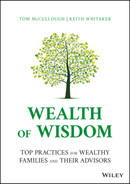SECTION 9
GIVING TOGETHER
One of the main findings in Wise Counsel Research's “100-Year Family Study” (a study of over 100 families that had succeeded in transitioning a major family enterprise through at least three generations of leadership) is that “connection to communities beyond the family” is a key factor in each family's success.
It is no surprise that many families intuitively turn to philanthropy as a way for individual members to make a positive difference in the world and for the family as a whole to feel connected through giving. As with any activity to do with families, self-understanding, communication, and empathy are crucial for this pursuit to go well.
In the first chapter of this section, Etienne Eichenberger, Małgorzata Smulowitz, and Peter Vogel offer a comprehensive approach for evaluating and enhancing giving together as a family. This process moves from understanding the family’s current focus and possible trade-offs it involves (e.g., between depth and breadth of impact), then to reformulating that focus based on input from family members. The authors also include a number of tips and insights for engaging rising generation family members in shaping the family’s philanthropic focus.
The rising generation is very much the focus for the second chapter, James “Jay” Hughes' reflections on grandparent-grandchild philanthropy. Jay guides readers in a simple way to structure shared giving between these two generations (key step: parents stay out!). He also points out the numerous benefits beyond the charitable from grandparent-grandchild philanthropy, in the form of sharing stories, giving grandchildren a chance to explain their choices, and fostering true understanding across the generations. It is a fine gift for families to give to themselves.
As the example of grandchild-grandparent philanthropy suggests, giving as a family is never a static activity: it changes as the family members themselves grow and change. Families can also intentionally change their style of philanthropy. That is the insight offered by Leslie Pine in the third chapter in this section, in which she describes a “philanthropic curve”—from becoming a donor to becoming more strategic to, ultimately, achieving high impact. This curve is a useful tool for evaluating where a family is now in its giving, where it wants to be, and what steps are needed to get there.
If charity begins at home, then, by the same principle, one could say that giving starts with the giver. In the final chapter in this section, Susan Winer asks the individual philanthropist to step back and reflect on the reasons or motivations for his or her giving. This checklist of motivations then can flow into defining the scope of one’s giving and even a statement describing its principles. This process of individual reflection is fundamental to giving well.
